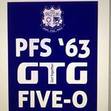Farouk Gulsara's Blog, page 133
January 23, 2018
Everyone, their own.
Aramm (அறம், Deed, Tamil; 2017)

This must be one of few attempts of Kollywood at a disaster movie; one which delves into the procedural intricacies of a rescue mission. It probably goes in the vein of great Hollywood flicks like 'Earthquake!', 'Jaws' and even 'Apollo 13'.
On top of dealing with the nitty-gritty issues of rescuing a child trapped in a disused well, the film managed to bring to light many of the issues plaguing the common man in Tamil Nadu, may be in anywhere in the world.
It is the eve of the launch of a rocket in India. The euphoric mood is palpable everywhere, but nobody seems to know what the hype is all about, but they join the revelry, nevertheless. On the one hand, the country appears to be at the zenith of technological know-how. At the same time, the state fails to satisfy its citizens' fundamental necessity, water supply. The film then focuses the plight of villager plagued with extreme water shortage. In this urgent situation, a toddler falls into a 93-feet narrow disused well.
It would have been just another sob story of a child from the disadvantaged class of the community succumbing to the negligence of the people entrusted to serve the people if not for the dedication of an IAS (Indian Administrative Service) officer. Her non-swaying stand against the powers that be exposes the lackadaisical attitude of the administrative arm of the Government, the partisan stance and the kowtowing of the police to the political leaders, the corrupt practices of the elected leaders and the ugly nature of class politics. The media can sometimes be a double-edged sword when their practitioners become overzealous in trying to expose a scoop.
The film ends on a positive note. It sends home the message that we determine our future. Nobody can be trusted to do our dirty work. We have to fend our ourselves. There is only so much that can be depended on the assistance of the state. Above all, we must have our own safety nets. Everyone is on the lookout for their own skin. http://asok22.wix.com/rifle-range-boy
http://.facebook.com/farouk.gulsara
www.riflerangeboy.com

This must be one of few attempts of Kollywood at a disaster movie; one which delves into the procedural intricacies of a rescue mission. It probably goes in the vein of great Hollywood flicks like 'Earthquake!', 'Jaws' and even 'Apollo 13'.
On top of dealing with the nitty-gritty issues of rescuing a child trapped in a disused well, the film managed to bring to light many of the issues plaguing the common man in Tamil Nadu, may be in anywhere in the world.
It is the eve of the launch of a rocket in India. The euphoric mood is palpable everywhere, but nobody seems to know what the hype is all about, but they join the revelry, nevertheless. On the one hand, the country appears to be at the zenith of technological know-how. At the same time, the state fails to satisfy its citizens' fundamental necessity, water supply. The film then focuses the plight of villager plagued with extreme water shortage. In this urgent situation, a toddler falls into a 93-feet narrow disused well.
It would have been just another sob story of a child from the disadvantaged class of the community succumbing to the negligence of the people entrusted to serve the people if not for the dedication of an IAS (Indian Administrative Service) officer. Her non-swaying stand against the powers that be exposes the lackadaisical attitude of the administrative arm of the Government, the partisan stance and the kowtowing of the police to the political leaders, the corrupt practices of the elected leaders and the ugly nature of class politics. The media can sometimes be a double-edged sword when their practitioners become overzealous in trying to expose a scoop.
The film ends on a positive note. It sends home the message that we determine our future. Nobody can be trusted to do our dirty work. We have to fend our ourselves. There is only so much that can be depended on the assistance of the state. Above all, we must have our own safety nets. Everyone is on the lookout for their own skin. http://asok22.wix.com/rifle-range-boy
http://.facebook.com/farouk.gulsara
www.riflerangeboy.com

Published on January 23, 2018 08:30
January 22, 2018
Your job, your God?
 I grew up in an environment where it was ingrained in us that a man can be a man only if he is productive. He has been sent to Earth on a mission and that purpose is to do his age-appropriate duties.
I grew up in an environment where it was ingrained in us that a man can be a man only if he is productive. He has been sent to Earth on a mission and that purpose is to do his age-appropriate duties.Amma used to remind us to keep a keen eye on the task at hand and not to be swayed by idle banter and purposeless chats. Her favourite Tamil proverb drove home her point - 'A talking dog is no use for hunting'! Appa, being the non-verbal one, asserted his teaching through his actions. In his 42 years' career, he never once called in sick, barring the times our family were stuck in floods when we were stuck in a relative's house when we visited them on a Sunday and the time he was admitted for diabetes.
 So, these thoughts came to my mind as I was passing through Singapore airport. If one had been to Singapore, he would not fail to notice the high numbers of members of the geriatric population still engaged in economic activities namely the service industry. In a food court, I could not keep my eyes off a severely kyphotic uniformed lady in her late sixties, probably, with a weak left upper limb dragging herself religiously clearing up the utensils and crumbs left by the patrons. She was working with such dexterity that would put an average adult to shame. When a looked around, I saw that everybody was working individually, focused on the job at hand. Nobody had time for small talks. It was just performance and the aim to have their tasks done. They were not robotic in that sense as they were just as forthcoming with pleasantries to the customer when warranted. The Japanese work ethics that our ex-Prime Minister was coaxing our population to emulate must have spilt over to our neighbours, never actually embraced by Malaysians. The river had flown leaving the source dry.
So, these thoughts came to my mind as I was passing through Singapore airport. If one had been to Singapore, he would not fail to notice the high numbers of members of the geriatric population still engaged in economic activities namely the service industry. In a food court, I could not keep my eyes off a severely kyphotic uniformed lady in her late sixties, probably, with a weak left upper limb dragging herself religiously clearing up the utensils and crumbs left by the patrons. She was working with such dexterity that would put an average adult to shame. When a looked around, I saw that everybody was working individually, focused on the job at hand. Nobody had time for small talks. It was just performance and the aim to have their tasks done. They were not robotic in that sense as they were just as forthcoming with pleasantries to the customer when warranted. The Japanese work ethics that our ex-Prime Minister was coaxing our population to emulate must have spilt over to our neighbours, never actually embraced by Malaysians. The river had flown leaving the source dry.A one-kilometre channel that separates these two countries seem to demarcate them worlds apart. A one-hour flight later at the luggage collection belt, what do I witness? Three able-bodied adults assigned to supervise the placing of luggage on the belt; one to adjust the placing, another to supervise him and yet another to supervise the other but more engaged in talking grandmother stories!http://asok22.wix.com/rifle-range-boy
http://.facebook.com/farouk.gulsara
www.riflerangeboy.com

Published on January 22, 2018 18:05
January 20, 2018
Coincidence or what?
Get a copy of the book 'Real Lessons in Reel Life' here... Your entry into the elusive world of Maya, the stage set by Man to learn from to live on the stage set by Nature. https://asok22.wixsite.com/real-lesson
 Asoka Chakra, quintessentially OdiyanFor 17 years, I have been receiving referrals from the world over. On the morning before my long procrastinated maiden trip to India, to Bhuvanesvar specifically, where did I receive a referral from? Well, what do you know? It is from Bhuvanesvar! If you do not call it coincidence, what else? Or is it that I am specifically on the lookout for these quirky incidences. Perhaps if I were to look at other tiny unimportant data, I would surely see a pattern and claim synchronicity! [Referral]
Asoka Chakra, quintessentially OdiyanFor 17 years, I have been receiving referrals from the world over. On the morning before my long procrastinated maiden trip to India, to Bhuvanesvar specifically, where did I receive a referral from? Well, what do you know? It is from Bhuvanesvar! If you do not call it coincidence, what else? Or is it that I am specifically on the lookout for these quirky incidences. Perhaps if I were to look at other tiny unimportant data, I would surely see a pattern and claim synchronicity! [Referral]Am I so important to the Universe that it decides to indulge in some kind of divine game? A mystical prank. That would be putting own self as a point of reference as if Nature gives a damn to the single individual.
In fact, complex mathematical formulas had been employed to calculate the possibilities of these seeming coincidences that defy logical explanations. The odds of experiencing these type of similar events are actually, not as low as we think it is. It is just that we fail to see other happenings that occur at similar frequency without we batting an eyelid to see them whiz us by.
Sorry to burst the bubble but there may not be a governing body in the Department of Synchronicity up there who is responsible for ensuring that events periodically happen at a pattern to show us who is The Boss! It is just an order in the chaos that we selectively choose to see.
Synchronicity (German: Synchronizität) is a concept, first introduced by analytical psychologist Carl Jung, which holds that events are "meaningful coincidences" if they occur with no causal relationship yet seem to be meaningfully related. ... Jung used the concept in arguing for the existence of the paranormal. [Ref:https://www.bibliotecapleyades.net/ciencia/ciencia_synchronicity05.htm]
(Listen to segment 19:00 through to 27:30)
Get a copy of the book 'Real Lessons in Reel Life' here...
Your entry into the elusive world of Maya, the stage set by Man to learn from to live on the stage set by Nature. https://asok22.wixsite.com/real-lesson
http://asok22.wix.com/rifle-range-boy
http://.facebook.com/farouk.gulsara
www.riflerangeboy.com

Published on January 20, 2018 08:01
January 19, 2018
50 Years Ago in Photos: A Look Back at 1968 (5/5)
(...Cont.)
ALAN TAYLOR JAN 10, 2018
https://www.theatlantic.com/photo/2018/01/50-years-ago-in-photos-a-look-back-at-1968/550208/
A half-century ago, much of the world appeared to be in a state of crisis. Protests erupted in France, Czechoslovakia. Germany, Mexico, Brazil, the United States, and many other places. Some of these protests ended peacefully; many were put down harshly. Two of the biggest catalysts for the protest were the U.S. involvement in the Vietnam War and the ongoing lack of civil rights in the U.S. and elsewhere. Two of America’s most prominent leaders, Dr Martin Luther King Jr. and Senator Robert F. Kennedy, were assassinated within months of each other. But some lessons were being learned and some progress was being made—this was also the year that NASA first sent astronauts around the moon and back, and the year President Lyndon Johnson signed the Civil Rights Act into law. It’s fitting that I post this retrospective today, since it is the day I was born—January 10, 1968. So, a 50th birthday present from me to you today: a look back at 1968.
[image error]
 A U.S. Marine keeps his head low as he drags a wounded buddy from the ruins of the Citadel's outer wall during the Battle of Hue in Vietnam on February 16, 1968. Bettmann / Getty
A U.S. Marine keeps his head low as he drags a wounded buddy from the ruins of the Citadel's outer wall during the Battle of Hue in Vietnam on February 16, 1968. Bettmann / Getty
 United States President Lyndon B. Johnson listens to a tape recording from his son-in-law Captain Charles Robb at the White House on July 31, 1968. Robb was a U.S. Marine Corps company commander in Vietnam at the time. Robb was later awarded the Bronze Star and, after returning home, became governor of Virginia in 1982, and later a senator for the same state. Jack Kightlinger / AP
United States President Lyndon B. Johnson listens to a tape recording from his son-in-law Captain Charles Robb at the White House on July 31, 1968. Robb was a U.S. Marine Corps company commander in Vietnam at the time. Robb was later awarded the Bronze Star and, after returning home, became governor of Virginia in 1982, and later a senator for the same state. Jack Kightlinger / AP
 Original caption: Several hundred hippies gathered at "Hippie Hill" in San Francisco's Golden Gate Park for a happening at which several bands played rock 'n' roll music. Most of the hippies sat and listened, but some just couldn't keep from dancing to the rhythms. Bettmann / Getty
Original caption: Several hundred hippies gathered at "Hippie Hill" in San Francisco's Golden Gate Park for a happening at which several bands played rock 'n' roll music. Most of the hippies sat and listened, but some just couldn't keep from dancing to the rhythms. Bettmann / Getty
 Mexican army soldiers crouch with weapons ready in Mexico City's Tlatelolco district, in this October 2, 1968 photo. The truth behind the stunning assault on a peaceful democracy protest known as the Tlatelolco Massacre, in which some 300 people are believed to have been killed, remains largely hidden by government and military secrecy. AP
Mexican army soldiers crouch with weapons ready in Mexico City's Tlatelolco district, in this October 2, 1968 photo. The truth behind the stunning assault on a peaceful democracy protest known as the Tlatelolco Massacre, in which some 300 people are believed to have been killed, remains largely hidden by government and military secrecy. AP
 Soldiers cut a student's hair after he was arrested during the first hour and a half of shooting in the Tlatelolco area in Mexico City on October 3, 1968. Another student stands against the wall. AP
Soldiers cut a student's hair after he was arrested during the first hour and a half of shooting in the Tlatelolco area in Mexico City on October 3, 1968. Another student stands against the wall. AP
 SRI’s Bill English, the engineer who built the first computer mouse prototype, prepares for the December 9, 1968 "mother of all demos." The demonstration is hailed as one of the most significant technological presentations in history, showcasing technologies that have become what we now know as modern computing. He gave the first public demonstration of a computer mouse, a graphical user interface, windowed computing, hypertext, word processing, video processing, and much more. SRI International
SRI’s Bill English, the engineer who built the first computer mouse prototype, prepares for the December 9, 1968 "mother of all demos." The demonstration is hailed as one of the most significant technological presentations in history, showcasing technologies that have become what we now know as modern computing. He gave the first public demonstration of a computer mouse, a graphical user interface, windowed computing, hypertext, word processing, video processing, and much more. SRI International
 Richard M. Nixon is mobbed by wildly cheering supporters as he arrives at the Hilton Plaza Hotel, his Miami Beach headquarters. Bettmann / CORBIS / Getty
Richard M. Nixon is mobbed by wildly cheering supporters as he arrives at the Hilton Plaza Hotel, his Miami Beach headquarters. Bettmann / CORBIS / Getty
 French Foreign Minister Michel Debre and U.S. President Lyndon Johnson watch television coverage of the flight of the Saturn 1 B Rocket launching from Cape Kennedy, Florida, on on October 11, 1968, in the White House Office in Washington, D.C. Charles Gorry / AP
French Foreign Minister Michel Debre and U.S. President Lyndon Johnson watch television coverage of the flight of the Saturn 1 B Rocket launching from Cape Kennedy, Florida, on on October 11, 1968, in the White House Office in Washington, D.C. Charles Gorry / AP
 A heavy beard covers the face of astronaut Walter M. Schirra Jr., Apollo 7 commander, as he looks out the rendezvous window in front of the commander's station on the ninth day of the Apollo 7 mission on October 20, 1968. Apollo 7 was the first Apollo mission to carry a crew, and it made 163 orbits around the Earth in 10 days, setting the stage for Apollo 8, which was heading to the moon. JSC / NASA
A heavy beard covers the face of astronaut Walter M. Schirra Jr., Apollo 7 commander, as he looks out the rendezvous window in front of the commander's station on the ninth day of the Apollo 7 mission on October 20, 1968. Apollo 7 was the first Apollo mission to carry a crew, and it made 163 orbits around the Earth in 10 days, setting the stage for Apollo 8, which was heading to the moon. JSC / NASA
 Apollo 8, the first manned mission to the moon, entered lunar orbit on Christmas Eve, December 24, 1968. That evening, the astronauts—Commander Frank Borman, Command Module Pilot Jim Lovell, and Lunar Module Pilot William Anders—held a live broadcast from lunar orbit, in which they showed pictures of the earth and moon as seen from their spacecraft. Said Lovell, "The vast loneliness is awe-inspiring and it makes you realize just what you have back there on Earth." They ended the broadcast with the crew taking turns reading from the book of Genesis. NASA
Apollo 8, the first manned mission to the moon, entered lunar orbit on Christmas Eve, December 24, 1968. That evening, the astronauts—Commander Frank Borman, Command Module Pilot Jim Lovell, and Lunar Module Pilot William Anders—held a live broadcast from lunar orbit, in which they showed pictures of the earth and moon as seen from their spacecraft. Said Lovell, "The vast loneliness is awe-inspiring and it makes you realize just what you have back there on Earth." They ended the broadcast with the crew taking turns reading from the book of Genesis. NASA
http://.facebook.com/farouk.gulsara
www.riflerangeboy.com
ALAN TAYLOR JAN 10, 2018
https://www.theatlantic.com/photo/2018/01/50-years-ago-in-photos-a-look-back-at-1968/550208/
A half-century ago, much of the world appeared to be in a state of crisis. Protests erupted in France, Czechoslovakia. Germany, Mexico, Brazil, the United States, and many other places. Some of these protests ended peacefully; many were put down harshly. Two of the biggest catalysts for the protest were the U.S. involvement in the Vietnam War and the ongoing lack of civil rights in the U.S. and elsewhere. Two of America’s most prominent leaders, Dr Martin Luther King Jr. and Senator Robert F. Kennedy, were assassinated within months of each other. But some lessons were being learned and some progress was being made—this was also the year that NASA first sent astronauts around the moon and back, and the year President Lyndon Johnson signed the Civil Rights Act into law. It’s fitting that I post this retrospective today, since it is the day I was born—January 10, 1968. So, a 50th birthday present from me to you today: a look back at 1968.
[image error]
 A U.S. Marine keeps his head low as he drags a wounded buddy from the ruins of the Citadel's outer wall during the Battle of Hue in Vietnam on February 16, 1968. Bettmann / Getty
A U.S. Marine keeps his head low as he drags a wounded buddy from the ruins of the Citadel's outer wall during the Battle of Hue in Vietnam on February 16, 1968. Bettmann / Getty United States President Lyndon B. Johnson listens to a tape recording from his son-in-law Captain Charles Robb at the White House on July 31, 1968. Robb was a U.S. Marine Corps company commander in Vietnam at the time. Robb was later awarded the Bronze Star and, after returning home, became governor of Virginia in 1982, and later a senator for the same state. Jack Kightlinger / AP
United States President Lyndon B. Johnson listens to a tape recording from his son-in-law Captain Charles Robb at the White House on July 31, 1968. Robb was a U.S. Marine Corps company commander in Vietnam at the time. Robb was later awarded the Bronze Star and, after returning home, became governor of Virginia in 1982, and later a senator for the same state. Jack Kightlinger / AP Original caption: Several hundred hippies gathered at "Hippie Hill" in San Francisco's Golden Gate Park for a happening at which several bands played rock 'n' roll music. Most of the hippies sat and listened, but some just couldn't keep from dancing to the rhythms. Bettmann / Getty
Original caption: Several hundred hippies gathered at "Hippie Hill" in San Francisco's Golden Gate Park for a happening at which several bands played rock 'n' roll music. Most of the hippies sat and listened, but some just couldn't keep from dancing to the rhythms. Bettmann / Getty Mexican army soldiers crouch with weapons ready in Mexico City's Tlatelolco district, in this October 2, 1968 photo. The truth behind the stunning assault on a peaceful democracy protest known as the Tlatelolco Massacre, in which some 300 people are believed to have been killed, remains largely hidden by government and military secrecy. AP
Mexican army soldiers crouch with weapons ready in Mexico City's Tlatelolco district, in this October 2, 1968 photo. The truth behind the stunning assault on a peaceful democracy protest known as the Tlatelolco Massacre, in which some 300 people are believed to have been killed, remains largely hidden by government and military secrecy. AP Soldiers cut a student's hair after he was arrested during the first hour and a half of shooting in the Tlatelolco area in Mexico City on October 3, 1968. Another student stands against the wall. AP
Soldiers cut a student's hair after he was arrested during the first hour and a half of shooting in the Tlatelolco area in Mexico City on October 3, 1968. Another student stands against the wall. AP SRI’s Bill English, the engineer who built the first computer mouse prototype, prepares for the December 9, 1968 "mother of all demos." The demonstration is hailed as one of the most significant technological presentations in history, showcasing technologies that have become what we now know as modern computing. He gave the first public demonstration of a computer mouse, a graphical user interface, windowed computing, hypertext, word processing, video processing, and much more. SRI International
SRI’s Bill English, the engineer who built the first computer mouse prototype, prepares for the December 9, 1968 "mother of all demos." The demonstration is hailed as one of the most significant technological presentations in history, showcasing technologies that have become what we now know as modern computing. He gave the first public demonstration of a computer mouse, a graphical user interface, windowed computing, hypertext, word processing, video processing, and much more. SRI International Richard M. Nixon is mobbed by wildly cheering supporters as he arrives at the Hilton Plaza Hotel, his Miami Beach headquarters. Bettmann / CORBIS / Getty
Richard M. Nixon is mobbed by wildly cheering supporters as he arrives at the Hilton Plaza Hotel, his Miami Beach headquarters. Bettmann / CORBIS / Getty French Foreign Minister Michel Debre and U.S. President Lyndon Johnson watch television coverage of the flight of the Saturn 1 B Rocket launching from Cape Kennedy, Florida, on on October 11, 1968, in the White House Office in Washington, D.C. Charles Gorry / AP
French Foreign Minister Michel Debre and U.S. President Lyndon Johnson watch television coverage of the flight of the Saturn 1 B Rocket launching from Cape Kennedy, Florida, on on October 11, 1968, in the White House Office in Washington, D.C. Charles Gorry / AP A heavy beard covers the face of astronaut Walter M. Schirra Jr., Apollo 7 commander, as he looks out the rendezvous window in front of the commander's station on the ninth day of the Apollo 7 mission on October 20, 1968. Apollo 7 was the first Apollo mission to carry a crew, and it made 163 orbits around the Earth in 10 days, setting the stage for Apollo 8, which was heading to the moon. JSC / NASA
A heavy beard covers the face of astronaut Walter M. Schirra Jr., Apollo 7 commander, as he looks out the rendezvous window in front of the commander's station on the ninth day of the Apollo 7 mission on October 20, 1968. Apollo 7 was the first Apollo mission to carry a crew, and it made 163 orbits around the Earth in 10 days, setting the stage for Apollo 8, which was heading to the moon. JSC / NASA Apollo 8, the first manned mission to the moon, entered lunar orbit on Christmas Eve, December 24, 1968. That evening, the astronauts—Commander Frank Borman, Command Module Pilot Jim Lovell, and Lunar Module Pilot William Anders—held a live broadcast from lunar orbit, in which they showed pictures of the earth and moon as seen from their spacecraft. Said Lovell, "The vast loneliness is awe-inspiring and it makes you realize just what you have back there on Earth." They ended the broadcast with the crew taking turns reading from the book of Genesis. NASA
Apollo 8, the first manned mission to the moon, entered lunar orbit on Christmas Eve, December 24, 1968. That evening, the astronauts—Commander Frank Borman, Command Module Pilot Jim Lovell, and Lunar Module Pilot William Anders—held a live broadcast from lunar orbit, in which they showed pictures of the earth and moon as seen from their spacecraft. Said Lovell, "The vast loneliness is awe-inspiring and it makes you realize just what you have back there on Earth." They ended the broadcast with the crew taking turns reading from the book of Genesis. NASAGet a copy of the book 'Real Lessons in Reel Life' here... Your entry into the elusive world of Maya, the stage set by Man to learn from to live on the stage set by Nature. https://asok22.wixsite.com/real-lessonhttp://asok22.wix.com/rifle-range-boy
http://.facebook.com/farouk.gulsara
www.riflerangeboy.com

Published on January 19, 2018 08:26
January 18, 2018
50 Years Ago in Photos: A Look Back at 1968 (4/5)
(...Cont.)
ALAN TAYLOR JAN 10, 2018
https://www.theatlantic.com/photo/2018/01/50-years-ago-in-photos-a-look-back-at-1968/550208/
A half-century ago, much of the world appeared to be in a state of crisis. Protests erupted in France, Czechoslovakia. Germany, Mexico, Brazil, the United States, and many other places. Some of these protests ended peacefully; many were put down harshly. Two of the biggest catalysts for the protest were the U.S. involvement in the Vietnam War and the ongoing lack of civil rights in the U.S. and elsewhere. Two of America’s most prominent leaders, Dr Martin Luther King Jr. and Senator Robert F. Kennedy, were assassinated within months of each other. But some lessons were being learned and some progress was being made—this was also the year that NASA first sent astronauts around the moon and back, and the year President Lyndon Johnson signed the Civil Rights Act into law. It’s fitting that I post this retrospective today, since it is the day I was born—January 10, 1968. So, a 50th birthday present from me to you today: a look back at 1968.
[image error]
 Coretta Scott King, widow of Martin Luther King Jr., walks past the casket containing the body of the assassinated Senator Robert F. Kennedy in St. Patrick's Cathedral in New York City on June 7, 1968. Bettmann / Getty
Coretta Scott King, widow of Martin Luther King Jr., walks past the casket containing the body of the assassinated Senator Robert F. Kennedy in St. Patrick's Cathedral in New York City on June 7, 1968. Bettmann / Getty
 A large crowd lines railroad tracks as the funeral train of Robert F. Kennedy passes on its way to Arlington National Cemetery in Washington, D.C. Bettmann / Getty
A large crowd lines railroad tracks as the funeral train of Robert F. Kennedy passes on its way to Arlington National Cemetery in Washington, D.C. Bettmann / Getty
[image error]
 Youths prepare to board buses for Chicago in August of 1968. Peace activists and anti-war groups organized to travel to Chicago to demonstrate outside the 1968 Democratic National Convention. AP
Youths prepare to board buses for Chicago in August of 1968. Peace activists and anti-war groups organized to travel to Chicago to demonstrate outside the 1968 Democratic National Convention. AP
 [image error]
[image error]
Police and demonstrators clash near the Conrad Hilton Hotel on Chicago's Michigan Avenue August 28, 1968, during the Democratic National Convention. Bettmann / Getty
 [image error]
[image error]
Mike Wallace, a CBS newsman, is hustled off the Democratic National Convention floor in the aftermath of a row between delegates and security officers during the nominating session on August 28, 1968 in Chicago. He was taken up a ramp to a second-floor room. AP
 Vice President Hubert Humphrey and his running mate, Sen. Edmund S. Muskie, with their wives shown at the final session Democratic Convention in Chicago following their nominations for president and vice president, on August 29, 1968. AP
Vice President Hubert Humphrey and his running mate, Sen. Edmund S. Muskie, with their wives shown at the final session Democratic Convention in Chicago following their nominations for president and vice president, on August 29, 1968. AP
 Members of the Black Panthers gather in front of entrance to the Alameda County Courthouse in Oakland, California, on July 15, 1968, to protest the trial of Huey Newton, 26, the founder of the Black Panthers. Newton went on trial for the slaying of an Oakland policeman and for wounding another officer on October 28. Ernest K. Bennett / AP
Members of the Black Panthers gather in front of entrance to the Alameda County Courthouse in Oakland, California, on July 15, 1968, to protest the trial of Huey Newton, 26, the founder of the Black Panthers. Newton went on trial for the slaying of an Oakland policeman and for wounding another officer on October 28. Ernest K. Bennett / AP
[image error]
 Original caption: Miami policemen, one holding the man's arm and the other with an arm lock on his neck, drag away a Negro youth during a clash between police and rioters in that city's predominantly Negro Liberty City district on August 8, 1968. Bettmann / Getty
Original caption: Miami policemen, one holding the man's arm and the other with an arm lock on his neck, drag away a Negro youth during a clash between police and rioters in that city's predominantly Negro Liberty City district on August 8, 1968. Bettmann / Getty
 Helicopters fly low during Operation Pegasus in Vietnam on April 5, 1968. They were taking part in the operation to relieve the Khe Sanh marine base, which had been under siege for the previous three months. Dang Van Phuoc / AP
Helicopters fly low during Operation Pegasus in Vietnam on April 5, 1968. They were taking part in the operation to relieve the Khe Sanh marine base, which had been under siege for the previous three months. Dang Van Phuoc / AP
[image error]
 Evidence of the My Lai Massacre. A photograph of Vietnamese women and children in My Lai before they were killed by U.S. soldiers in the massacre on March 16, 1968. According to court testimony, they were killed seconds after the photo was taken. The woman on the right is adjusting her blouse buttons because of a sexual assault that happened before the massacre. Image taken from Volume III, Book 6, of the Report of the Department of the Army Review of the Preliminary Investigations into the My Lai Incident, photographed by United States Army photographer Ronald L. Haeberle. Ronald L. Haeberle / U.S. Army
Evidence of the My Lai Massacre. A photograph of Vietnamese women and children in My Lai before they were killed by U.S. soldiers in the massacre on March 16, 1968. According to court testimony, they were killed seconds after the photo was taken. The woman on the right is adjusting her blouse buttons because of a sexual assault that happened before the massacre. Image taken from Volume III, Book 6, of the Report of the Department of the Army Review of the Preliminary Investigations into the My Lai Incident, photographed by United States Army photographer Ronald L. Haeberle. Ronald L. Haeberle / U.S. Army
http://asok22.wix.com/rifle-range-boy
http://.facebook.com/farouk.gulsara
www.riflerangeboy.com
ALAN TAYLOR JAN 10, 2018
https://www.theatlantic.com/photo/2018/01/50-years-ago-in-photos-a-look-back-at-1968/550208/
A half-century ago, much of the world appeared to be in a state of crisis. Protests erupted in France, Czechoslovakia. Germany, Mexico, Brazil, the United States, and many other places. Some of these protests ended peacefully; many were put down harshly. Two of the biggest catalysts for the protest were the U.S. involvement in the Vietnam War and the ongoing lack of civil rights in the U.S. and elsewhere. Two of America’s most prominent leaders, Dr Martin Luther King Jr. and Senator Robert F. Kennedy, were assassinated within months of each other. But some lessons were being learned and some progress was being made—this was also the year that NASA first sent astronauts around the moon and back, and the year President Lyndon Johnson signed the Civil Rights Act into law. It’s fitting that I post this retrospective today, since it is the day I was born—January 10, 1968. So, a 50th birthday present from me to you today: a look back at 1968.
[image error]
 Coretta Scott King, widow of Martin Luther King Jr., walks past the casket containing the body of the assassinated Senator Robert F. Kennedy in St. Patrick's Cathedral in New York City on June 7, 1968. Bettmann / Getty
Coretta Scott King, widow of Martin Luther King Jr., walks past the casket containing the body of the assassinated Senator Robert F. Kennedy in St. Patrick's Cathedral in New York City on June 7, 1968. Bettmann / Getty A large crowd lines railroad tracks as the funeral train of Robert F. Kennedy passes on its way to Arlington National Cemetery in Washington, D.C. Bettmann / Getty
A large crowd lines railroad tracks as the funeral train of Robert F. Kennedy passes on its way to Arlington National Cemetery in Washington, D.C. Bettmann / Getty[image error]
 Youths prepare to board buses for Chicago in August of 1968. Peace activists and anti-war groups organized to travel to Chicago to demonstrate outside the 1968 Democratic National Convention. AP
Youths prepare to board buses for Chicago in August of 1968. Peace activists and anti-war groups organized to travel to Chicago to demonstrate outside the 1968 Democratic National Convention. AP [image error]
[image error]Police and demonstrators clash near the Conrad Hilton Hotel on Chicago's Michigan Avenue August 28, 1968, during the Democratic National Convention. Bettmann / Getty
 [image error]
[image error]Mike Wallace, a CBS newsman, is hustled off the Democratic National Convention floor in the aftermath of a row between delegates and security officers during the nominating session on August 28, 1968 in Chicago. He was taken up a ramp to a second-floor room. AP
 Vice President Hubert Humphrey and his running mate, Sen. Edmund S. Muskie, with their wives shown at the final session Democratic Convention in Chicago following their nominations for president and vice president, on August 29, 1968. AP
Vice President Hubert Humphrey and his running mate, Sen. Edmund S. Muskie, with their wives shown at the final session Democratic Convention in Chicago following their nominations for president and vice president, on August 29, 1968. AP Members of the Black Panthers gather in front of entrance to the Alameda County Courthouse in Oakland, California, on July 15, 1968, to protest the trial of Huey Newton, 26, the founder of the Black Panthers. Newton went on trial for the slaying of an Oakland policeman and for wounding another officer on October 28. Ernest K. Bennett / AP
Members of the Black Panthers gather in front of entrance to the Alameda County Courthouse in Oakland, California, on July 15, 1968, to protest the trial of Huey Newton, 26, the founder of the Black Panthers. Newton went on trial for the slaying of an Oakland policeman and for wounding another officer on October 28. Ernest K. Bennett / AP[image error]
 Original caption: Miami policemen, one holding the man's arm and the other with an arm lock on his neck, drag away a Negro youth during a clash between police and rioters in that city's predominantly Negro Liberty City district on August 8, 1968. Bettmann / Getty
Original caption: Miami policemen, one holding the man's arm and the other with an arm lock on his neck, drag away a Negro youth during a clash between police and rioters in that city's predominantly Negro Liberty City district on August 8, 1968. Bettmann / Getty Helicopters fly low during Operation Pegasus in Vietnam on April 5, 1968. They were taking part in the operation to relieve the Khe Sanh marine base, which had been under siege for the previous three months. Dang Van Phuoc / AP
Helicopters fly low during Operation Pegasus in Vietnam on April 5, 1968. They were taking part in the operation to relieve the Khe Sanh marine base, which had been under siege for the previous three months. Dang Van Phuoc / AP[image error]
 Evidence of the My Lai Massacre. A photograph of Vietnamese women and children in My Lai before they were killed by U.S. soldiers in the massacre on March 16, 1968. According to court testimony, they were killed seconds after the photo was taken. The woman on the right is adjusting her blouse buttons because of a sexual assault that happened before the massacre. Image taken from Volume III, Book 6, of the Report of the Department of the Army Review of the Preliminary Investigations into the My Lai Incident, photographed by United States Army photographer Ronald L. Haeberle. Ronald L. Haeberle / U.S. Army
Evidence of the My Lai Massacre. A photograph of Vietnamese women and children in My Lai before they were killed by U.S. soldiers in the massacre on March 16, 1968. According to court testimony, they were killed seconds after the photo was taken. The woman on the right is adjusting her blouse buttons because of a sexual assault that happened before the massacre. Image taken from Volume III, Book 6, of the Report of the Department of the Army Review of the Preliminary Investigations into the My Lai Incident, photographed by United States Army photographer Ronald L. Haeberle. Ronald L. Haeberle / U.S. Armyhttp://asok22.wix.com/rifle-range-boy
http://.facebook.com/farouk.gulsara
www.riflerangeboy.com

Published on January 18, 2018 08:19
January 17, 2018
50 Years Ago in Photos: A Look Back at 1968 (3/5)
(...Cont.)
ALAN TAYLOR JAN 10, 2018
https://www.theatlantic.com/photo/2018/01/50-years-ago-in-photos-a-look-back-at-1968/550208/
A half-century ago, much of the world appeared to be in a state of crisis. Protests erupted in France, Czechoslovakia. Germany, Mexico, Brazil, the United States, and many other places. Some of these protests ended peacefully; many were put down harshly. Two of the biggest catalysts for the protest were the U.S. involvement in the Vietnam War and the ongoing lack of civil rights in the U.S. and elsewhere. Two of America’s most prominent leaders, Dr Martin Luther King Jr. and Senator Robert F. Kennedy, were assassinated within months of each other. But some lessons were being learned and some progress was being made—this was also the year that NASA first sent astronauts around the moon and back, and the year President Lyndon Johnson signed the Civil Rights Act into law. It’s fitting that I post this retrospective today, since it is the day I was born—January 10, 1968. So, a 50th birthday present from me to you today: a look back at 1968.
 Demonstrators march on Washington, D.C., during the Poor Peoples' Campaign Solidarity Day on June 19, 1968. Charles Tasnadi / AP
Demonstrators march on Washington, D.C., during the Poor Peoples' Campaign Solidarity Day on June 19, 1968. Charles Tasnadi / AP
 [image error]The Beatles pose together on February 28, 1968. From left are Paul McCartney, John Lennon, Ringo Starr, and George Harrison. This was the year they released the White Album. AP
[image error]The Beatles pose together on February 28, 1968. From left are Paul McCartney, John Lennon, Ringo Starr, and George Harrison. This was the year they released the White Album. AP
 [image error]
[image error]
American actor Gary Lockwood on the set of 2001: A Space Odyssey, written and directed by Stanley Kubrick. The groundbreaking film premiered in April of 1968, and earned the Academy Award for Best Visual Effects. Sunset Boulevard / Corbis via Getty
[image error]
 A propaganda image from China's Cultural Revolution. In 1968, China was in a phase of their Cultural Revolution where Chairman Mao Zedong's cult of personality was still being elevated, and intellectuals and disloyal citizens were being forced into labor camps or exiled to remote farming regions. Original caption: Members of the Sichuan Province Revolving Committee unite with civilians and soldiers to work in the fields on August 26, 1968. API / Gamma-Rapho via Getty
A propaganda image from China's Cultural Revolution. In 1968, China was in a phase of their Cultural Revolution where Chairman Mao Zedong's cult of personality was still being elevated, and intellectuals and disloyal citizens were being forced into labor camps or exiled to remote farming regions. Original caption: Members of the Sichuan Province Revolving Committee unite with civilians and soldiers to work in the fields on August 26, 1968. API / Gamma-Rapho via Getty
 [image error]
[image error]
Federal Nigerian troops walk along a road near Ikot Expene, Nigeria, to the frontier with Biafra, a few miles away, on October 13, 1968. On the roadside, two emaciated Nigerian boys slowly die from starvation and malnutrition. Biafra was a breakaway state within Nigeria that fought a war for independence from 1967 to 1970, ending after years of fighting and a crippling blockade by Nigeria resulted in the deaths of between 500,000 and two million Biafran civilians by starvation. Dennis Lee Royle / AP
 [image error]
[image error]
A street scene from Pittsburgh, Pennsylvania, Grant St. at 5th Ave. on August 24, 1968. See the same scene today in Google Street View.CC BY David Wilson
 [image error]
[image error]
Original caption: A Feminine First. Mexico City: Mexico's Norma Enriqueta Basilio, the first woman in the history of the modern Olympic Games to light the Olympic Fire, runs up the 90 steps with the Olympic Torch during the opening ceremonies here on October 12, 1968. Bettmann / Getty
 Tommie Smith and John Carlos, gold and bronze medalists in the 200-meter run at the 1968 Olympic Games, engage in a victory stand protest against unfair treatment of blacks in the United States. With heads lowered and black-gloved fists raised in the black power salute, they refused to recognize the American flag and national anthem. Australian Peter Norman is the silver medalist. Bettmann / Getty
Tommie Smith and John Carlos, gold and bronze medalists in the 200-meter run at the 1968 Olympic Games, engage in a victory stand protest against unfair treatment of blacks in the United States. With heads lowered and black-gloved fists raised in the black power salute, they refused to recognize the American flag and national anthem. Australian Peter Norman is the silver medalist. Bettmann / Getty
[image error]
 Senator Robert F. Kennedy is surrounded by hundreds of people as he leans down to shake hands during a presidential campaign appearance at a street corner in central Philadelphia on April 2, 1968. Kennedy had declared his candidacy for the presidency of the United States only weeks earlier, on March 16. AP
Senator Robert F. Kennedy is surrounded by hundreds of people as he leans down to shake hands during a presidential campaign appearance at a street corner in central Philadelphia on April 2, 1968. Kennedy had declared his candidacy for the presidency of the United States only weeks earlier, on March 16. AP
[image error]
 Senator Robert Kennedy lies sprawled, semi-conscious in his own blood after being shot in the head and neck while busboy Juan Romero tries to comfort him in kitchen in the Ambassador Hotel in Los Angeles, California, on June 5, 1968. A Palestinian immigrant named Sirhan Sirhan, who was angry with Kennedy over his support for Israel, shot Kennedy three times. Sirhan remains in prison to this day, last denied parole in 2016. Bill Eppridge / The LIFE Picture Collection / Getty
Senator Robert Kennedy lies sprawled, semi-conscious in his own blood after being shot in the head and neck while busboy Juan Romero tries to comfort him in kitchen in the Ambassador Hotel in Los Angeles, California, on June 5, 1968. A Palestinian immigrant named Sirhan Sirhan, who was angry with Kennedy over his support for Israel, shot Kennedy three times. Sirhan remains in prison to this day, last denied parole in 2016. Bill Eppridge / The LIFE Picture Collection / Getty
http://asok22.wix.com/rifle-range-boy
http://.facebook.com/farouk.gulsara
www.riflerangeboy.com
ALAN TAYLOR JAN 10, 2018
https://www.theatlantic.com/photo/2018/01/50-years-ago-in-photos-a-look-back-at-1968/550208/
A half-century ago, much of the world appeared to be in a state of crisis. Protests erupted in France, Czechoslovakia. Germany, Mexico, Brazil, the United States, and many other places. Some of these protests ended peacefully; many were put down harshly. Two of the biggest catalysts for the protest were the U.S. involvement in the Vietnam War and the ongoing lack of civil rights in the U.S. and elsewhere. Two of America’s most prominent leaders, Dr Martin Luther King Jr. and Senator Robert F. Kennedy, were assassinated within months of each other. But some lessons were being learned and some progress was being made—this was also the year that NASA first sent astronauts around the moon and back, and the year President Lyndon Johnson signed the Civil Rights Act into law. It’s fitting that I post this retrospective today, since it is the day I was born—January 10, 1968. So, a 50th birthday present from me to you today: a look back at 1968.
 Demonstrators march on Washington, D.C., during the Poor Peoples' Campaign Solidarity Day on June 19, 1968. Charles Tasnadi / AP
Demonstrators march on Washington, D.C., during the Poor Peoples' Campaign Solidarity Day on June 19, 1968. Charles Tasnadi / AP [image error]The Beatles pose together on February 28, 1968. From left are Paul McCartney, John Lennon, Ringo Starr, and George Harrison. This was the year they released the White Album. AP
[image error]The Beatles pose together on February 28, 1968. From left are Paul McCartney, John Lennon, Ringo Starr, and George Harrison. This was the year they released the White Album. AP [image error]
[image error]American actor Gary Lockwood on the set of 2001: A Space Odyssey, written and directed by Stanley Kubrick. The groundbreaking film premiered in April of 1968, and earned the Academy Award for Best Visual Effects. Sunset Boulevard / Corbis via Getty
[image error]
 A propaganda image from China's Cultural Revolution. In 1968, China was in a phase of their Cultural Revolution where Chairman Mao Zedong's cult of personality was still being elevated, and intellectuals and disloyal citizens were being forced into labor camps or exiled to remote farming regions. Original caption: Members of the Sichuan Province Revolving Committee unite with civilians and soldiers to work in the fields on August 26, 1968. API / Gamma-Rapho via Getty
A propaganda image from China's Cultural Revolution. In 1968, China was in a phase of their Cultural Revolution where Chairman Mao Zedong's cult of personality was still being elevated, and intellectuals and disloyal citizens were being forced into labor camps or exiled to remote farming regions. Original caption: Members of the Sichuan Province Revolving Committee unite with civilians and soldiers to work in the fields on August 26, 1968. API / Gamma-Rapho via Getty [image error]
[image error]Federal Nigerian troops walk along a road near Ikot Expene, Nigeria, to the frontier with Biafra, a few miles away, on October 13, 1968. On the roadside, two emaciated Nigerian boys slowly die from starvation and malnutrition. Biafra was a breakaway state within Nigeria that fought a war for independence from 1967 to 1970, ending after years of fighting and a crippling blockade by Nigeria resulted in the deaths of between 500,000 and two million Biafran civilians by starvation. Dennis Lee Royle / AP
 [image error]
[image error]A street scene from Pittsburgh, Pennsylvania, Grant St. at 5th Ave. on August 24, 1968. See the same scene today in Google Street View.CC BY David Wilson
 [image error]
[image error]Original caption: A Feminine First. Mexico City: Mexico's Norma Enriqueta Basilio, the first woman in the history of the modern Olympic Games to light the Olympic Fire, runs up the 90 steps with the Olympic Torch during the opening ceremonies here on October 12, 1968. Bettmann / Getty
 Tommie Smith and John Carlos, gold and bronze medalists in the 200-meter run at the 1968 Olympic Games, engage in a victory stand protest against unfair treatment of blacks in the United States. With heads lowered and black-gloved fists raised in the black power salute, they refused to recognize the American flag and national anthem. Australian Peter Norman is the silver medalist. Bettmann / Getty
Tommie Smith and John Carlos, gold and bronze medalists in the 200-meter run at the 1968 Olympic Games, engage in a victory stand protest against unfair treatment of blacks in the United States. With heads lowered and black-gloved fists raised in the black power salute, they refused to recognize the American flag and national anthem. Australian Peter Norman is the silver medalist. Bettmann / Getty[image error]
 Senator Robert F. Kennedy is surrounded by hundreds of people as he leans down to shake hands during a presidential campaign appearance at a street corner in central Philadelphia on April 2, 1968. Kennedy had declared his candidacy for the presidency of the United States only weeks earlier, on March 16. AP
Senator Robert F. Kennedy is surrounded by hundreds of people as he leans down to shake hands during a presidential campaign appearance at a street corner in central Philadelphia on April 2, 1968. Kennedy had declared his candidacy for the presidency of the United States only weeks earlier, on March 16. AP[image error]
 Senator Robert Kennedy lies sprawled, semi-conscious in his own blood after being shot in the head and neck while busboy Juan Romero tries to comfort him in kitchen in the Ambassador Hotel in Los Angeles, California, on June 5, 1968. A Palestinian immigrant named Sirhan Sirhan, who was angry with Kennedy over his support for Israel, shot Kennedy three times. Sirhan remains in prison to this day, last denied parole in 2016. Bill Eppridge / The LIFE Picture Collection / Getty
Senator Robert Kennedy lies sprawled, semi-conscious in his own blood after being shot in the head and neck while busboy Juan Romero tries to comfort him in kitchen in the Ambassador Hotel in Los Angeles, California, on June 5, 1968. A Palestinian immigrant named Sirhan Sirhan, who was angry with Kennedy over his support for Israel, shot Kennedy three times. Sirhan remains in prison to this day, last denied parole in 2016. Bill Eppridge / The LIFE Picture Collection / Gettyhttp://asok22.wix.com/rifle-range-boy
http://.facebook.com/farouk.gulsara
www.riflerangeboy.com

Published on January 17, 2018 08:10
January 16, 2018
50 Years Ago in Photos: A Look Back at 1968 (2/5)
(...Cont.)
ALAN TAYLOR JAN 10, 2018
https://www.theatlantic.com/photo/2018/01/50-years-ago-in-photos-a-look-back-at-1968/550208/
A half-century ago, much of the world appeared to be in a state of crisis. Protests erupted in France, Czechoslovakia. Germany, Mexico, Brazil, the United States, and many other places. Some of these protests ended peacefully; many were put down harshly. Two of the biggest catalysts for the protest were the U.S. involvement in the Vietnam War and the ongoing lack of civil rights in the U.S. and elsewhere. Two of America’s most prominent leaders, Dr Martin Luther King Jr. and Senator Robert F. Kennedy, were assassinated within months of each other. But some lessons were being learned and some progress was being made—this was also the year that NASA first sent astronauts around the moon and back, and the year President Lyndon Johnson signed the Civil Rights Act into law. It’s fitting that I post this retrospective today, since it is the day I was born—January 10, 1968. So, a 50th birthday present from me to you today: a look back at 1968.
 One of the last pictures to be taken of Dr. Martin Luther King Jr., as he spoke to a mass rally in Memphis on April 3rd, saying he would not halt his plans for a massive demonstration scheduled for April 8 in spite of a federal injunction. Bettmann / Getty
One of the last pictures to be taken of Dr. Martin Luther King Jr., as he spoke to a mass rally in Memphis on April 3rd, saying he would not halt his plans for a massive demonstration scheduled for April 8 in spite of a federal injunction. Bettmann / Getty
 Civil-rights leader Andrew Young (left) and others stand on the balcony of the Lorraine Motel pointing in the direction of an assailant after the assassination of civil-rights leader Dr. Martin Luther King Jr., who is lying at their feet, in Memphis, Tennessee, on April 4, 1968. Joseph Louw / The LIFE Images Collection / Getty
Civil-rights leader Andrew Young (left) and others stand on the balcony of the Lorraine Motel pointing in the direction of an assailant after the assassination of civil-rights leader Dr. Martin Luther King Jr., who is lying at their feet, in Memphis, Tennessee, on April 4, 1968. Joseph Louw / The LIFE Images Collection / Getty
 This aerial view shows clouds of smoke rising from burning buildings in northeast Washington, D.C., on April 5, 1968. The fires resulted from rioting and demonstrations after the assassination of Dr. Martin Luther King Jr. AP
This aerial view shows clouds of smoke rising from burning buildings in northeast Washington, D.C., on April 5, 1968. The fires resulted from rioting and demonstrations after the assassination of Dr. Martin Luther King Jr. AP
[image error]
 Firemen battle a blaze on 125th Street in Harlem, New York, on April 4, 1968, after a furniture store and other buildings were set on fire after it was learned that civil-rights leader Dr. Martin Luther King Jr. had been assassinated. AP
Firemen battle a blaze on 125th Street in Harlem, New York, on April 4, 1968, after a furniture store and other buildings were set on fire after it was learned that civil-rights leader Dr. Martin Luther King Jr. had been assassinated. AP
 President Johnson called federal troops into the nation's capital to restore peace after a day of arson, looting, and violence on April 5, 1968. Here, a trooper stands guard in the street as another (left) patrols a completely demolished building. Bettmann / Getty
President Johnson called federal troops into the nation's capital to restore peace after a day of arson, looting, and violence on April 5, 1968. Here, a trooper stands guard in the street as another (left) patrols a completely demolished building. Bettmann / Getty
 Coretta Scott King, the widow of Martin Luther King Jr., walks on the arm of Dr. Ralph Abernathy, her husband's successor as head of the Southern Christian Leadership conference, leading about 10,000 people in a memorial march to the slain Dr. King. The King children, Yolanda, Martin III, and Dexter are at left with Harry Belafonte. Reverend Andrew Young marches next to Dr. Abernathy.
Coretta Scott King, the widow of Martin Luther King Jr., walks on the arm of Dr. Ralph Abernathy, her husband's successor as head of the Southern Christian Leadership conference, leading about 10,000 people in a memorial march to the slain Dr. King. The King children, Yolanda, Martin III, and Dexter are at left with Harry Belafonte. Reverend Andrew Young marches next to Dr. Abernathy.
Bettmann / Getty
 Original caption: DDrTimothy Leary holds a conference in New York City on February 21, 1968. The LSD advocate said he is tuning in with peaceniks and “Yippies” and hopes to have a million young people in Chicago during the Democratic Party’s convention in August. He said he hopes they will disrupt the convention through “Flower Guerrilla” warfare. At left is Abbie Hoffman, who said he is an organizer and at right is Jerry Rubin, peace movement worker. AP
Original caption: DDrTimothy Leary holds a conference in New York City on February 21, 1968. The LSD advocate said he is tuning in with peaceniks and “Yippies” and hopes to have a million young people in Chicago during the Democratic Party’s convention in August. He said he hopes they will disrupt the convention through “Flower Guerrilla” warfare. At left is Abbie Hoffman, who said he is an organizer and at right is Jerry Rubin, peace movement worker. AP
 1968 was truly a year of protest around the world. Here in Rio de Janeiro, Brazil, state police cavalry charge students attending a memorial mass for Edson Luis de Lima Souto, a student killed by police, at Candelaria Church on April 4, 1968. Edson had been part of an earlier protest over high prices in a restaurant in downtown Rio, and was shot by police who were trying to remove students from premises. Agencia JB / AP
1968 was truly a year of protest around the world. Here in Rio de Janeiro, Brazil, state police cavalry charge students attending a memorial mass for Edson Luis de Lima Souto, a student killed by police, at Candelaria Church on April 4, 1968. Edson had been part of an earlier protest over high prices in a restaurant in downtown Rio, and was shot by police who were trying to remove students from premises. Agencia JB / AP
 Violent clashes between policeman and students take place during the May 1968 protests in Paris, France. [Editor's note: This photo replaces a previous image in this position that had been mislabeled by the source.] Jacques Haillot / Apis / Sygma via Getty
Violent clashes between policeman and students take place during the May 1968 protests in Paris, France. [Editor's note: This photo replaces a previous image in this position that had been mislabeled by the source.] Jacques Haillot / Apis / Sygma via Getty
[image error]
 A massive anti-Vietnam war demonstration in London on March 18, 1968. Hundreds were arrested as they demonstrated outside the United States embassy. Corbis via Gettyhttp://asok22.wix.com/rifle-range-boy
A massive anti-Vietnam war demonstration in London on March 18, 1968. Hundreds were arrested as they demonstrated outside the United States embassy. Corbis via Gettyhttp://asok22.wix.com/rifle-range-boy
http://.facebook.com/farouk.gulsara
www.riflerangeboy.com
ALAN TAYLOR JAN 10, 2018
https://www.theatlantic.com/photo/2018/01/50-years-ago-in-photos-a-look-back-at-1968/550208/
A half-century ago, much of the world appeared to be in a state of crisis. Protests erupted in France, Czechoslovakia. Germany, Mexico, Brazil, the United States, and many other places. Some of these protests ended peacefully; many were put down harshly. Two of the biggest catalysts for the protest were the U.S. involvement in the Vietnam War and the ongoing lack of civil rights in the U.S. and elsewhere. Two of America’s most prominent leaders, Dr Martin Luther King Jr. and Senator Robert F. Kennedy, were assassinated within months of each other. But some lessons were being learned and some progress was being made—this was also the year that NASA first sent astronauts around the moon and back, and the year President Lyndon Johnson signed the Civil Rights Act into law. It’s fitting that I post this retrospective today, since it is the day I was born—January 10, 1968. So, a 50th birthday present from me to you today: a look back at 1968.
 One of the last pictures to be taken of Dr. Martin Luther King Jr., as he spoke to a mass rally in Memphis on April 3rd, saying he would not halt his plans for a massive demonstration scheduled for April 8 in spite of a federal injunction. Bettmann / Getty
One of the last pictures to be taken of Dr. Martin Luther King Jr., as he spoke to a mass rally in Memphis on April 3rd, saying he would not halt his plans for a massive demonstration scheduled for April 8 in spite of a federal injunction. Bettmann / Getty Civil-rights leader Andrew Young (left) and others stand on the balcony of the Lorraine Motel pointing in the direction of an assailant after the assassination of civil-rights leader Dr. Martin Luther King Jr., who is lying at their feet, in Memphis, Tennessee, on April 4, 1968. Joseph Louw / The LIFE Images Collection / Getty
Civil-rights leader Andrew Young (left) and others stand on the balcony of the Lorraine Motel pointing in the direction of an assailant after the assassination of civil-rights leader Dr. Martin Luther King Jr., who is lying at their feet, in Memphis, Tennessee, on April 4, 1968. Joseph Louw / The LIFE Images Collection / Getty This aerial view shows clouds of smoke rising from burning buildings in northeast Washington, D.C., on April 5, 1968. The fires resulted from rioting and demonstrations after the assassination of Dr. Martin Luther King Jr. AP
This aerial view shows clouds of smoke rising from burning buildings in northeast Washington, D.C., on April 5, 1968. The fires resulted from rioting and demonstrations after the assassination of Dr. Martin Luther King Jr. AP[image error]
 Firemen battle a blaze on 125th Street in Harlem, New York, on April 4, 1968, after a furniture store and other buildings were set on fire after it was learned that civil-rights leader Dr. Martin Luther King Jr. had been assassinated. AP
Firemen battle a blaze on 125th Street in Harlem, New York, on April 4, 1968, after a furniture store and other buildings were set on fire after it was learned that civil-rights leader Dr. Martin Luther King Jr. had been assassinated. AP President Johnson called federal troops into the nation's capital to restore peace after a day of arson, looting, and violence on April 5, 1968. Here, a trooper stands guard in the street as another (left) patrols a completely demolished building. Bettmann / Getty
President Johnson called federal troops into the nation's capital to restore peace after a day of arson, looting, and violence on April 5, 1968. Here, a trooper stands guard in the street as another (left) patrols a completely demolished building. Bettmann / Getty Coretta Scott King, the widow of Martin Luther King Jr., walks on the arm of Dr. Ralph Abernathy, her husband's successor as head of the Southern Christian Leadership conference, leading about 10,000 people in a memorial march to the slain Dr. King. The King children, Yolanda, Martin III, and Dexter are at left with Harry Belafonte. Reverend Andrew Young marches next to Dr. Abernathy.
Coretta Scott King, the widow of Martin Luther King Jr., walks on the arm of Dr. Ralph Abernathy, her husband's successor as head of the Southern Christian Leadership conference, leading about 10,000 people in a memorial march to the slain Dr. King. The King children, Yolanda, Martin III, and Dexter are at left with Harry Belafonte. Reverend Andrew Young marches next to Dr. Abernathy. Bettmann / Getty
 Original caption: DDrTimothy Leary holds a conference in New York City on February 21, 1968. The LSD advocate said he is tuning in with peaceniks and “Yippies” and hopes to have a million young people in Chicago during the Democratic Party’s convention in August. He said he hopes they will disrupt the convention through “Flower Guerrilla” warfare. At left is Abbie Hoffman, who said he is an organizer and at right is Jerry Rubin, peace movement worker. AP
Original caption: DDrTimothy Leary holds a conference in New York City on February 21, 1968. The LSD advocate said he is tuning in with peaceniks and “Yippies” and hopes to have a million young people in Chicago during the Democratic Party’s convention in August. He said he hopes they will disrupt the convention through “Flower Guerrilla” warfare. At left is Abbie Hoffman, who said he is an organizer and at right is Jerry Rubin, peace movement worker. AP 1968 was truly a year of protest around the world. Here in Rio de Janeiro, Brazil, state police cavalry charge students attending a memorial mass for Edson Luis de Lima Souto, a student killed by police, at Candelaria Church on April 4, 1968. Edson had been part of an earlier protest over high prices in a restaurant in downtown Rio, and was shot by police who were trying to remove students from premises. Agencia JB / AP
1968 was truly a year of protest around the world. Here in Rio de Janeiro, Brazil, state police cavalry charge students attending a memorial mass for Edson Luis de Lima Souto, a student killed by police, at Candelaria Church on April 4, 1968. Edson had been part of an earlier protest over high prices in a restaurant in downtown Rio, and was shot by police who were trying to remove students from premises. Agencia JB / AP Violent clashes between policeman and students take place during the May 1968 protests in Paris, France. [Editor's note: This photo replaces a previous image in this position that had been mislabeled by the source.] Jacques Haillot / Apis / Sygma via Getty
Violent clashes between policeman and students take place during the May 1968 protests in Paris, France. [Editor's note: This photo replaces a previous image in this position that had been mislabeled by the source.] Jacques Haillot / Apis / Sygma via Getty[image error]
 A massive anti-Vietnam war demonstration in London on March 18, 1968. Hundreds were arrested as they demonstrated outside the United States embassy. Corbis via Gettyhttp://asok22.wix.com/rifle-range-boy
A massive anti-Vietnam war demonstration in London on March 18, 1968. Hundreds were arrested as they demonstrated outside the United States embassy. Corbis via Gettyhttp://asok22.wix.com/rifle-range-boyhttp://.facebook.com/farouk.gulsara
www.riflerangeboy.com

Published on January 16, 2018 14:06
January 15, 2018
50 Years Ago in Photos: A Look Back at 1968 (1/5)
https://www.theatlantic.com/photo/2018/01/50-years-ago-in-photos-a-look-back-at-1968/550208/
50 Years Ago in Photos: A Look Back at 1968
ALAN TAYLOR
JAN 10, 2018
A half-century ago, much of the world appeared to be in a state of crisis. Protests erupted in France, Czechoslovakia. Germany, Mexico, Brazil, the United States, and many other places. Some of these protests ended peacefully; many were put down harshly. Two of the biggest catalysts for the protest were the U.S. involvement in the Vietnam War and the ongoing lack of civil rights in the U.S. and elsewhere. Two of America’s most prominent leaders, Dr Martin Luther King Jr. and Senator Robert F. Kennedy, were assassinated within months of each other. But some lessons were being learned and some progress was being made—this was also the year that NASA first sent astronauts around the moon and back, and the year President Lyndon Johnson signed the Civil Rights Act into law. It’s fitting that I post this retrospective today, since it is the day I was born—January 10, 1968. So, a 50th birthday present from me to you today: a look back at 1968.
 U.S. National Guard troops block off Beale Street in Memphis, Tennessee, as Civil Rights marchers wearing placards reading, "I AM A MAN" pass by on March 29, 1968. It was the third consecutive march held by the group in as many days. Bettmann / Getty
U.S. National Guard troops block off Beale Street in Memphis, Tennessee, as Civil Rights marchers wearing placards reading, "I AM A MAN" pass by on March 29, 1968. It was the third consecutive march held by the group in as many days. Bettmann / Getty
[image error]
 The Supremes, with Diana Ross, front, Cindy Birdsong, and Mary Wilson dance with their arms in the air as they perform at the annual "Bal pare" party in Munich, West Germany, on January 21, 1968. The American trio was backed by the West German Rolf Hans Mueller big band and was celebrated with thundering applause. Frings / AP
The Supremes, with Diana Ross, front, Cindy Birdsong, and Mary Wilson dance with their arms in the air as they perform at the annual "Bal pare" party in Munich, West Germany, on January 21, 1968. The American trio was backed by the West German Rolf Hans Mueller big band and was celebrated with thundering applause. Frings / AP
 The flag of South Vietnam flies atop a tower of the main fortified structure in the old citadel as a jeep crosses a bridge over a moat in Hue during the Tet Offensive in February of 1968. AP
The flag of South Vietnam flies atop a tower of the main fortified structure in the old citadel as a jeep crosses a bridge over a moat in Hue during the Tet Offensive in February of 1968. AP
[image error]
 South Vietnamese General Nguyen Ngoc Loan, chief of the national police, fires his pistol, executing suspected Viet Cong officer Nguyen Van Lem (also known as Bay Lop) on a Saigon street on February 1, 1968, early in the Tet Offensive. Lem was suspected of commanding a death squad which had targeted South Vietnamese police officers that day. The fame of this photo led to a life of infamy for Nguyen Ngoc Loan, who quietly moved to the United States in 1975 and opened a pizza shop in Virginia. Eddie Adams / AP
South Vietnamese General Nguyen Ngoc Loan, chief of the national police, fires his pistol, executing suspected Viet Cong officer Nguyen Van Lem (also known as Bay Lop) on a Saigon street on February 1, 1968, early in the Tet Offensive. Lem was suspected of commanding a death squad which had targeted South Vietnamese police officers that day. The fame of this photo led to a life of infamy for Nguyen Ngoc Loan, who quietly moved to the United States in 1975 and opened a pizza shop in Virginia. Eddie Adams / AP
 A U.S Marine with several days of beard growth sits in a helicopter on July 18, 1968, after being picked up from a landing zone near Con Thein on the southern edge of the demilitarized zone in South Vietnam. His unit had just been relieved of duty after patrolling the region around the DMZ. Stone / AP
A U.S Marine with several days of beard growth sits in a helicopter on July 18, 1968, after being picked up from a landing zone near Con Thein on the southern edge of the demilitarized zone in South Vietnam. His unit had just been relieved of duty after patrolling the region around the DMZ. Stone / AP
[image error]
 A speaker addresses a mass rally in support of democracy organized by the youth of Prague at the Old Town Square in Prague, Czechoslovakia, on May 18, 1968. During a period called the "Prague Spring," Alexander Dubček, the newly-elected leader of the Warsaw Pact nation, enacted numerous reforms loosening state control and expanding individual rights, which both encouraged citizens and angered the Soviet Union. Bettmann / Getty
A speaker addresses a mass rally in support of democracy organized by the youth of Prague at the Old Town Square in Prague, Czechoslovakia, on May 18, 1968. During a period called the "Prague Spring," Alexander Dubček, the newly-elected leader of the Warsaw Pact nation, enacted numerous reforms loosening state control and expanding individual rights, which both encouraged citizens and angered the Soviet Union. Bettmann / Getty
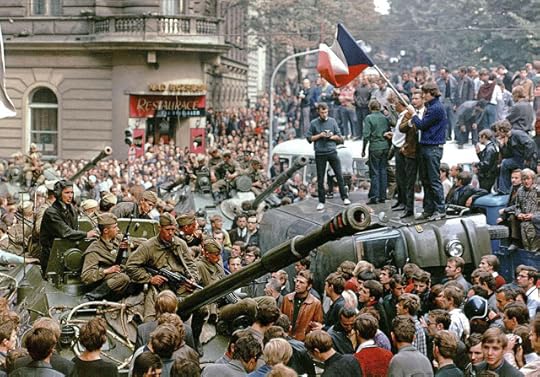 Prague residents surround Soviet tanks in front of the Czechoslovak Radio station building in central Prague during the first day of a Soviet-led invasion of Czechoslovakia on August 21, 1968. Within a year, Dubček was removed from office, his reforms were undone, and a more Soviet-controlled government was installed. Libor Hajsky / Reuters
Prague residents surround Soviet tanks in front of the Czechoslovak Radio station building in central Prague during the first day of a Soviet-led invasion of Czechoslovakia on August 21, 1968. Within a year, Dubček was removed from office, his reforms were undone, and a more Soviet-controlled government was installed. Libor Hajsky / Reuters
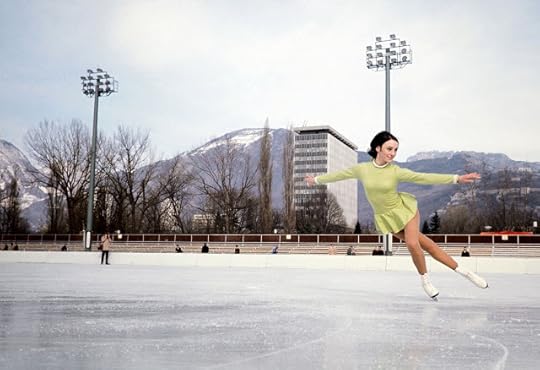 American figure skater Peggy Fleming practices on an outside rink on February 1968 in Grenoble, in the French Alps, during the 1968 Winter Olympic Games. Fleming took the gold medal in women's figure skating. AFP / Getty
American figure skater Peggy Fleming practices on an outside rink on February 1968 in Grenoble, in the French Alps, during the 1968 Winter Olympic Games. Fleming took the gold medal in women's figure skating. AFP / Getty
[image error]
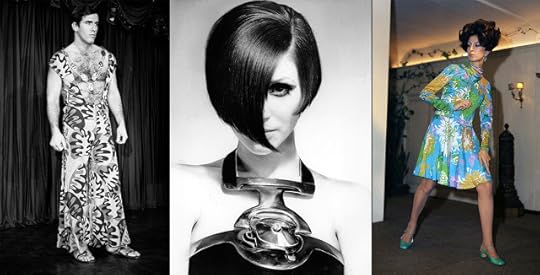 Fashion in 1968. Left: A male model wears a silk jersey print pajama leisure suit, sandals, and a necklace at a fashion show in New York on January 9. The show was entitled "Clothing for the Emancipated Man." Center: A sculpted silver necklace designed by Pierre Cardin features a diamond worth $60,000. The necklace is built into the halter that is part of a long black crepe evening gown presented in his spring collection in Paris, France, in February. Right: A cocktail dress of printed pure silk with a full skirt, a creation by the Fontana Sisters fashion house of Rome, to be presented at the upcoming Italian spring-summer ready-to-wear fashion show that opened in Florence on November 6, 1968. AP, AP, Mario Torrisi / AP
Fashion in 1968. Left: A male model wears a silk jersey print pajama leisure suit, sandals, and a necklace at a fashion show in New York on January 9. The show was entitled "Clothing for the Emancipated Man." Center: A sculpted silver necklace designed by Pierre Cardin features a diamond worth $60,000. The necklace is built into the halter that is part of a long black crepe evening gown presented in his spring collection in Paris, France, in February. Right: A cocktail dress of printed pure silk with a full skirt, a creation by the Fontana Sisters fashion house of Rome, to be presented at the upcoming Italian spring-summer ready-to-wear fashion show that opened in Florence on November 6, 1968. AP, AP, Mario Torrisi / AP
http://asok22.wix.com/rifle-range-boy
http://.facebook.com/farouk.gulsara
www.riflerangeboy.com
50 Years Ago in Photos: A Look Back at 1968
ALAN TAYLOR
JAN 10, 2018
A half-century ago, much of the world appeared to be in a state of crisis. Protests erupted in France, Czechoslovakia. Germany, Mexico, Brazil, the United States, and many other places. Some of these protests ended peacefully; many were put down harshly. Two of the biggest catalysts for the protest were the U.S. involvement in the Vietnam War and the ongoing lack of civil rights in the U.S. and elsewhere. Two of America’s most prominent leaders, Dr Martin Luther King Jr. and Senator Robert F. Kennedy, were assassinated within months of each other. But some lessons were being learned and some progress was being made—this was also the year that NASA first sent astronauts around the moon and back, and the year President Lyndon Johnson signed the Civil Rights Act into law. It’s fitting that I post this retrospective today, since it is the day I was born—January 10, 1968. So, a 50th birthday present from me to you today: a look back at 1968.
 U.S. National Guard troops block off Beale Street in Memphis, Tennessee, as Civil Rights marchers wearing placards reading, "I AM A MAN" pass by on March 29, 1968. It was the third consecutive march held by the group in as many days. Bettmann / Getty
U.S. National Guard troops block off Beale Street in Memphis, Tennessee, as Civil Rights marchers wearing placards reading, "I AM A MAN" pass by on March 29, 1968. It was the third consecutive march held by the group in as many days. Bettmann / Getty[image error]
 The Supremes, with Diana Ross, front, Cindy Birdsong, and Mary Wilson dance with their arms in the air as they perform at the annual "Bal pare" party in Munich, West Germany, on January 21, 1968. The American trio was backed by the West German Rolf Hans Mueller big band and was celebrated with thundering applause. Frings / AP
The Supremes, with Diana Ross, front, Cindy Birdsong, and Mary Wilson dance with their arms in the air as they perform at the annual "Bal pare" party in Munich, West Germany, on January 21, 1968. The American trio was backed by the West German Rolf Hans Mueller big band and was celebrated with thundering applause. Frings / AP The flag of South Vietnam flies atop a tower of the main fortified structure in the old citadel as a jeep crosses a bridge over a moat in Hue during the Tet Offensive in February of 1968. AP
The flag of South Vietnam flies atop a tower of the main fortified structure in the old citadel as a jeep crosses a bridge over a moat in Hue during the Tet Offensive in February of 1968. AP[image error]
 South Vietnamese General Nguyen Ngoc Loan, chief of the national police, fires his pistol, executing suspected Viet Cong officer Nguyen Van Lem (also known as Bay Lop) on a Saigon street on February 1, 1968, early in the Tet Offensive. Lem was suspected of commanding a death squad which had targeted South Vietnamese police officers that day. The fame of this photo led to a life of infamy for Nguyen Ngoc Loan, who quietly moved to the United States in 1975 and opened a pizza shop in Virginia. Eddie Adams / AP
South Vietnamese General Nguyen Ngoc Loan, chief of the national police, fires his pistol, executing suspected Viet Cong officer Nguyen Van Lem (also known as Bay Lop) on a Saigon street on February 1, 1968, early in the Tet Offensive. Lem was suspected of commanding a death squad which had targeted South Vietnamese police officers that day. The fame of this photo led to a life of infamy for Nguyen Ngoc Loan, who quietly moved to the United States in 1975 and opened a pizza shop in Virginia. Eddie Adams / AP A U.S Marine with several days of beard growth sits in a helicopter on July 18, 1968, after being picked up from a landing zone near Con Thein on the southern edge of the demilitarized zone in South Vietnam. His unit had just been relieved of duty after patrolling the region around the DMZ. Stone / AP
A U.S Marine with several days of beard growth sits in a helicopter on July 18, 1968, after being picked up from a landing zone near Con Thein on the southern edge of the demilitarized zone in South Vietnam. His unit had just been relieved of duty after patrolling the region around the DMZ. Stone / AP[image error]
 A speaker addresses a mass rally in support of democracy organized by the youth of Prague at the Old Town Square in Prague, Czechoslovakia, on May 18, 1968. During a period called the "Prague Spring," Alexander Dubček, the newly-elected leader of the Warsaw Pact nation, enacted numerous reforms loosening state control and expanding individual rights, which both encouraged citizens and angered the Soviet Union. Bettmann / Getty
A speaker addresses a mass rally in support of democracy organized by the youth of Prague at the Old Town Square in Prague, Czechoslovakia, on May 18, 1968. During a period called the "Prague Spring," Alexander Dubček, the newly-elected leader of the Warsaw Pact nation, enacted numerous reforms loosening state control and expanding individual rights, which both encouraged citizens and angered the Soviet Union. Bettmann / Getty Prague residents surround Soviet tanks in front of the Czechoslovak Radio station building in central Prague during the first day of a Soviet-led invasion of Czechoslovakia on August 21, 1968. Within a year, Dubček was removed from office, his reforms were undone, and a more Soviet-controlled government was installed. Libor Hajsky / Reuters
Prague residents surround Soviet tanks in front of the Czechoslovak Radio station building in central Prague during the first day of a Soviet-led invasion of Czechoslovakia on August 21, 1968. Within a year, Dubček was removed from office, his reforms were undone, and a more Soviet-controlled government was installed. Libor Hajsky / Reuters American figure skater Peggy Fleming practices on an outside rink on February 1968 in Grenoble, in the French Alps, during the 1968 Winter Olympic Games. Fleming took the gold medal in women's figure skating. AFP / Getty
American figure skater Peggy Fleming practices on an outside rink on February 1968 in Grenoble, in the French Alps, during the 1968 Winter Olympic Games. Fleming took the gold medal in women's figure skating. AFP / Getty[image error]
 Fashion in 1968. Left: A male model wears a silk jersey print pajama leisure suit, sandals, and a necklace at a fashion show in New York on January 9. The show was entitled "Clothing for the Emancipated Man." Center: A sculpted silver necklace designed by Pierre Cardin features a diamond worth $60,000. The necklace is built into the halter that is part of a long black crepe evening gown presented in his spring collection in Paris, France, in February. Right: A cocktail dress of printed pure silk with a full skirt, a creation by the Fontana Sisters fashion house of Rome, to be presented at the upcoming Italian spring-summer ready-to-wear fashion show that opened in Florence on November 6, 1968. AP, AP, Mario Torrisi / AP
Fashion in 1968. Left: A male model wears a silk jersey print pajama leisure suit, sandals, and a necklace at a fashion show in New York on January 9. The show was entitled "Clothing for the Emancipated Man." Center: A sculpted silver necklace designed by Pierre Cardin features a diamond worth $60,000. The necklace is built into the halter that is part of a long black crepe evening gown presented in his spring collection in Paris, France, in February. Right: A cocktail dress of printed pure silk with a full skirt, a creation by the Fontana Sisters fashion house of Rome, to be presented at the upcoming Italian spring-summer ready-to-wear fashion show that opened in Florence on November 6, 1968. AP, AP, Mario Torrisi / APhttp://asok22.wix.com/rifle-range-boy
http://.facebook.com/farouk.gulsara
www.riflerangeboy.com

Published on January 15, 2018 15:41
January 13, 2018
Disorganised synchronicity?
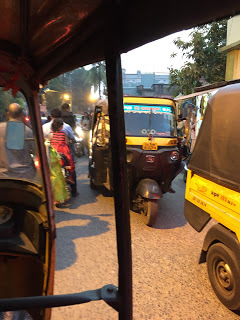 The first day on the road trip told me all, that there is order in chaos. The haphazard needling and swerving of 'auto' vehicles with the constant blaring of car horns just complemented the irate of the impatient road users stuck at the railway crossing at the heat of high noon.
The first day on the road trip told me all, that there is order in chaos. The haphazard needling and swerving of 'auto' vehicles with the constant blaring of car horns just complemented the irate of the impatient road users stuck at the railway crossing at the heat of high noon.Nevertheless, my host tells me later, there had never been a fatal road accident in Cuttack, the second biggest town in Orissa (rebranded Odisha).
It precisely describes the dynamics of how the system works in the greater part of India. On one hand, you have the poorest of the victims of globalisation, scrapping the barren barrel of hopelessness whilst the end sees the shakers of global conglomerates. You have the victims of caste segregation deprived of basic amenities, decency and opportunities. Then there are the heart-wrenching tales not much different than of Ambedkar's rise from rags to fame.
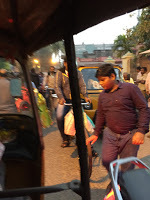 There are minions who find contentment in living a whole life performing menial repetitive tasks and there are entrepreneurs with Earth-shattering proposals with simplest of devices. There is wisdom in the mundane.
There are minions who find contentment in living a whole life performing menial repetitive tasks and there are entrepreneurs with Earth-shattering proposals with simplest of devices. There is wisdom in the mundane.It is a land of extremes, the land of plenty as well as one dearth of substance. It takes a kind of something to make India go around. With the dense population and the hive of activities, despite the chaos that goes on a daily basis, it is a wonder that things actually move forward. It is one place that proves the butterfly effect may, in fact, be a real thing. A little flutter and a little wave there may just upset the whole dynamic of things. Things appear chaotic but in that bizarre scenario, the sun still rises and things get done, nevertheless. http://asok22.wix.com/rifle-range-boy
http://.facebook.com/farouk.gulsara
www.riflerangeboy.com

Published on January 13, 2018 23:59
January 6, 2018
It is all in the mind!
The Man Without a Past
(
Mies Vailla Menneisyyttä, Finnish; 2002)
Director, Producer, Written: Aki Kaurismäki
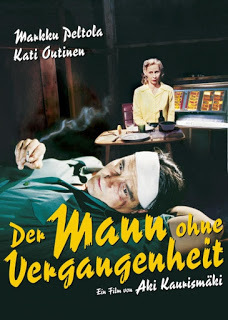
We are who we are all because of our senses. The composite of the input of senses that are fed to us, with the processing by our associative neurons and the limbic system, showcase us to the world as the unique individual that we are. Our likes, dislikes, values, beliefs, relationships, moods and personalities are all products of these inputs woven together by memory. The memory of the things that we learn along the way, paves the path to follow and adapt to the social mores that are appropriate for our surroundings. When the faculty of recollection fails, we become zombies that just follow the herd like automata.
Kaurismäki's movies are acquired tastes. The acting appears robotic and the actors look expressionless. Herein lies the quirky sense of humour that hits subtly. Along the way, it is apparent that the director also hits a low blow to the modern capitalistic free economy.
In this second offering of Karrismäki's 'Finland trilogy', the unnamed protagonist, credited as 'M', finds himself lost in Helsinki. After being hit on the head by hooligans while sleeping at a park and robbed of his belongings. He wonders around without knowing his purpose of being there, his past and even his name. With the help of container-dwelling fringe society of town, he tries to get himself together. By no means, it is a walk in the park as his existence seem to depend on his pass - his identity, social security number etcetera.
He just seems to be an unwanted figure existing without a soul to care. It finally changes when he gets embroiled in a bank robbery.http://asok22.wix.com/rifle-range-boy
http://.facebook.com/farouk.gulsara
www.riflerangeboy.com
Director, Producer, Written: Aki Kaurismäki

We are who we are all because of our senses. The composite of the input of senses that are fed to us, with the processing by our associative neurons and the limbic system, showcase us to the world as the unique individual that we are. Our likes, dislikes, values, beliefs, relationships, moods and personalities are all products of these inputs woven together by memory. The memory of the things that we learn along the way, paves the path to follow and adapt to the social mores that are appropriate for our surroundings. When the faculty of recollection fails, we become zombies that just follow the herd like automata.
Kaurismäki's movies are acquired tastes. The acting appears robotic and the actors look expressionless. Herein lies the quirky sense of humour that hits subtly. Along the way, it is apparent that the director also hits a low blow to the modern capitalistic free economy.
In this second offering of Karrismäki's 'Finland trilogy', the unnamed protagonist, credited as 'M', finds himself lost in Helsinki. After being hit on the head by hooligans while sleeping at a park and robbed of his belongings. He wonders around without knowing his purpose of being there, his past and even his name. With the help of container-dwelling fringe society of town, he tries to get himself together. By no means, it is a walk in the park as his existence seem to depend on his pass - his identity, social security number etcetera.
He just seems to be an unwanted figure existing without a soul to care. It finally changes when he gets embroiled in a bank robbery.http://asok22.wix.com/rifle-range-boy
http://.facebook.com/farouk.gulsara
www.riflerangeboy.com

Published on January 06, 2018 08:03

